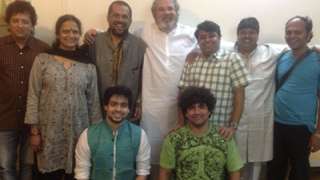MEDIA
Sonic mode
www.punemirror.com | August 14, 2019
Scientists studying creativity have been looking at how creativity is a specific thinking process, and that there is a science behind what is otherwise popularly believed to be an abstract phenomenon. Since the late 1990s, the fields of artistic research and research-creation have sought to combine artistic and academic research practices. One of the aims of these fields is to better understand the nature of creativity. “It is a new way of rese arch where the results are artistic. Research labs consult artists because they have a different perspective of the world,” says Indo-German composer and researcher Sandeep Bhagwati.

Bhagwati, a professor of music at the Faculty of Fine Arts, Concordia University, Montreal, is also director of MatraLab, a research-creation centre for intercultural and inter-disciplinary arts, where he is currently developing the Ecstasies of Influence project to understand how creative strategies could be transferred from different art forms into music. “Each artist has his or her own way of thinking. So, I thought, a musician could be influenced by the way an architect or a visual artist thinks and processes their creative strategy. Pure curiosity drove me to see if it is at all possible through experimentation,” says Bhagwati, whose research forms the basis for a musical show entitled Ecstasies of Influence, which will be performed by FLAME University’s Ensemble Sangeet Prayog today.
The show will feature vocalists Sameer Dublay and Arpana Gurav, violinist Swapna Datar, sitar player Sweekar Katti, and Charudatta Phadke on table, with Govind Bhilare on pakhawaj. The performers have collaboratively designed the show, for which they drew insights through interactions with city-based architect Rahul Ravat and Bharatanatyam artiste and choreographer Priya Joshi.
Architectural design, which is an architect’s creative strategy for an allocated space, inspired the musicians to create a musical piece where a plot of land is intepreted through teental beats. Short rhythmic variations, two and three-matra tihai, which conclude the renditions, represent the limitations imposed by an architectural space. “By using tihai, which limits the use of the 16 beats, we tried to experience the creative thinking process of an architect while developing our music,” says Dublay, a disciple of Pandit Ashok Da Ranade of Gwalior Gharana and an associate professor of music at FLAME University.
The Natanam Adinar, from Bharatanatyam’s repertoire, forms the basis of another piece in Ecstasies of Influence. The musicians learnt from Joshi how her creative process involved understanding the text first, then looking at the music, and, at the third level, thinking about the dance movements. Dublay explains, “We created a sound pattern out of the text and then looked at the musical possibilities hidden in the recitation of the text. At the third level, we created actual music from the text.”
(Source: https://punemirror.indiatimes.com/entertainment/unwind/sonic-mode/articleshow/70664049.cms)

